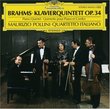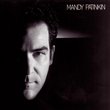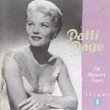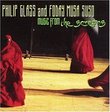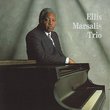| All Artists: Wilhelm Friedemann Bach, Jeanne Lamon, Tafelmusik, Charlotte Nediger Title: Wilhelm Friedemann Bach: Sinfonias / Suite in G minor / Concerto for Harpsichord in D Major - Charlotte Nediger / Tafelmusik / Jeanne Lamon Members Wishing: 1 Total Copies: 0 Label: Sony Vivarte Release Date: 5/20/1997 Genre: Classical Styles: Forms & Genres, Concertos, Instruments, Keyboard, Symphonies Number of Discs: 1 SwapaCD Credits: 1 UPC: 074646272022 |
Search - Wilhelm Friedemann Bach, Jeanne Lamon, Tafelmusik :: Wilhelm Friedemann Bach: Sinfonias / Suite in G minor / Concerto for Harpsichord in D Major - Charlotte Nediger / Tafelmusik / Jeanne Lamon
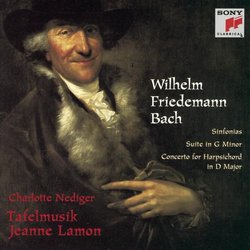 | Wilhelm Friedemann Bach, Jeanne Lamon, Tafelmusik Wilhelm Friedemann Bach: Sinfonias / Suite in G minor / Concerto for Harpsichord in D Major - Charlotte Nediger / Tafelmusik / Jeanne Lamon Genre: Classical
W.F. was Bach's oldest son, and musical history hasn't been kind to him for a number of reasons. Apparently he had a drinking problem or some other behavioral difficulty, since he seemed to have trouble keeping a job. Wh... more » |
Larger Image |
CD DetailsSynopsis
Amazon.com W.F. was Bach's oldest son, and musical history hasn't been kind to him for a number of reasons. Apparently he had a drinking problem or some other behavioral difficulty, since he seemed to have trouble keeping a job. When his father died, he received a third of his music manuscripts and proceeded to sell or pawn them, which is why so many of Bach's cantatas and other works are lost. As a composer his music obviously shows something of his father's influence, and possibly that of alcohol--and many great musicians have been alcoholics. Well, his music is certainly interesting, and these are fine performances. Give them a whirl. --David Hurwitz Similarly Requested CDs
|
CD ReviewsOutstanding Baroque music R. FISCHER | Glen Ellyn, Illinois | 11/28/2002 (5 out of 5 stars) "I have to agree with Shirley from Canada (above). This is probably one of the best Baroque period CDs around. This music, played on period instruments, is almost unknown to today's audience, and unfortunately they're missing a lot of enjoyment. In these days of mass marketing and the superficiality of Brittany Spears and Eminem, what a relief to not join the masses and instead transport yourself back 300 years. It offers something for your core being that can't be found in today's music. The recording is also top-notch and will sound excellent on the best high-end components. Highly recommended, especially at this price." Baby Bach in Dresden A Certain Bibliophile | 04/15/2010 (5 out of 5 stars) "When Johann Sebastian Bach armed his son Wilhem Friedemann for an organ competition at the Sophien Kirche in Dresden in 1733 with a letter of application and a showpiece to perform, he probably wasn't thinking about helping his eldest son secure what in many ways was an unprofitable (not least of all financially) post as organist, he was probably more concerned with having his son break into Dresden's renowned musical life. As the older Bach was himself seeking the title of court composer in Dresden at the time, he may have hoped that Friedemann would find a suitable opportunity to join the court orchestra there. Whatever his expectations, they were not met; after less than thirteen years in the employ of the Sophien Kirche, Wilhelm Friedemann Bach left the Saxon capital to fill the prestigious position of music director and organist at the Church of Our Lady (today Marktkirche) in Halle.
We have little information concerning what Wilhem Friedemann did to establish himself in Dresden. The church post, which consisted of playing the organ on Sunday, Monday mornings, and holiday services, could not have absorbed all of the composer's time, leaving him ample opportunity for his own musical activities. For example, in a letter to the wife of the Saxon Elector, Maria Antonia Walpurgis, Wilhelm Friedemann recalls the musical soiree she invited him to attend. Such specific sources, however, are of limited value in drawing conclusions. We might also speculate that he attended and even participated in musical performances at the house of Count Keyserlingk, the famous commissioner of the Goldberg Variations and an important patron of musical life in Dresden at that time. In any case, a number of chamber and orchestral works from his Dresden period have survived, which could only have been written for Court circles. Among these works in the Sinfonia in F major (F. 67), whose capricious fast movements owe much to the instrumental style of Jan Dismas Zelenka; the tender Andante, on the other hand, reminds us of certain of the opera arias Johann Adolph Hasse composed for Dresden. The closing Minuet with its canonic trio is clearly one of Wilhelm Friedemann's favorites, since he used it again in a number of other works. Unlike the whimsical and humorous Sinfonia in F major, the Sinfonia in D minor (F. 65), in two movements, is unusually serious. For a long time it was unclear how the work came about; greater familiarity with the local traditions, however, lends one to believe that it was probably written in Dresden, a supposition confirmed by studying the manuscript more. The Sinfonia in D minor is one of a large number of similar orchestral works that were performed in the Dresden Catholic Hoffkirche as instrumental graduals during the mass. The sostenuto of the slow movement and the strict counterpoint of the fast movement are determined by the work's function and are quite characteristic of Dresden church music from around 1740. Judging from the manuscript score, the Harpsichord Concerto in D major (F. 41) was composed during the late 1730s, or at about the same time as Johann Sebastian Bach's solo concerti for the same instrument. The work is extraordinary in many ways. The first movement expressed the piece's severity in its predominantly canonic treatment of the individual motifs and a subsidiary subject in the minor key; some two-thirds through the movement, an unexpected cadence in F-sharp minor brings the music to a complete stop, only to return to the opening key in a reprise-like final section. The elegiac and graceful Andante consists of a delicately balanced dialogue between harpsichord and strings, which continues in the fiery concluding Presto. The Sinfonia in D major (F. 64) belongs to a later period. The work was probably written in the mid-1750s during Wilhelm Friedemann's period as organist and music director in Halle. We have proof that it was played as the instrumental introduction to the Pentecost cantata Dies ist der Tag [This is the Day], (F. 85) and must have served a similar function in other church and occasional music. Unlike the Sinfonia in D minor, the work is not influenced by the church style, which means that a separate performance in a secular setting was not only possible but probably desired by the composer. This magnificent, mature work clearly stands apart from the earlier Dresden sinfonias. The rather bizarre style of the Dresden High Baroque, with its extravagant harmonies and rhythms, yields to a balanced, varied, and subtle treatment of the musical material. The Overture Suite in G minor is one of the "orphans" of Bach scholarship. Since this work was attributed to Johann Sebastian Bach in a copy made in 1753 by his pupil Christian Friedrich Penzel, it was included, with reservations, in the Bach catalogue as BWV 1070, though even a cursory glance at the score shows this to be a mistake. During the preparation of the New Bach Edition, someone suggested that it might be the work of Wilhelm Friedemann Bach. Movement headings such as "Torneo" and "Capriccio," however, would seem to point to a Southern German or Austrian composer for this undoubtedly fascinating work, and the fact that the piece appears in a Saxon source around 1750 could be traced to the close ties between Dresden and Vienna. " |

 Track Listings (16) - Disc #1
Track Listings (16) - Disc #1